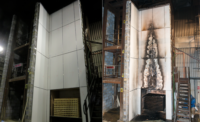Wrenches Put In Tower's Works












































...glass panes within a mullion system supported at each floor, says Johann Sischka, the firm’s senior vice president.
Though the cladding is more complicated that most curtain-wall systems, Sischka adopted a prefabrication method to facilitate the installation. “I believe nobody has done it before...with such a structure,” he says.
The firm is prefabricating roughly 8-m-tall diamond-shaped panels, which crews are currently superimposing on the diagrids. The two-story-deep panels are 7 m to 9 m wide and include 18 pieces of glass panes of different sizes.
Over 700 panels will form the roughly 23,000 sq m of cladding, according to Sischka. Nearly 23,000 pieces of steel will form the cladding’s framework, and each is different, he adds. In the hotel areas and some other places, plans call for a ventilated double facade, which will reduce energy use.
Waagner-Biro is having the facade steel laser-cut in Germany and Slovakia and shipped in containers to the Gulf. Workers are assembling and painting cladding panels in Abu Dhabi in an off-site plant.
Having started in January, crews from Waagner-Biro have installed the panels about halfway up the tower. The team is rigidly attaching each diamond-shaped panel to the diagrid at its center point. Additional fixings at the panels’ top corners allow vertical and horizontal movement relative to the diagrid. Fixings at corners on either side can slide only horizontally.
The panels must be free to move relative to the building both to accommodate normal tolerances and the effect of the precambering, says Sischka. Joints between panels are 5.5 cm wide with 0.2 cm tolerance. Sischka estimates total movement between panels due to the precamber at 1 cm.
The main contract called for work to end next month. But, “at the moment we are heading for a shell, core and cladding completion at the end of October,” says Fullarton. The building at least must look complete for Abu Dhabi’s first-ever Formula One car Grand Prix race on Nov. 1, he adds.
MACE joined the job in July 2007, when construction prices were going “through the roof,” says Fullarton. “Most contractors were hit.”
Speaking generally, he says owners in the region have since tried to gain from the recession by pushing for price cuts. But with prices typically fixed in contracts, the situation has become “tricky,” adds Fullarton. Anyway, the regional construction recession may now be turning, he hints. “Steel is going up in price as is concrete,” Fullarton points out.

















